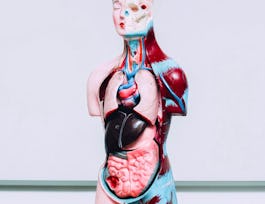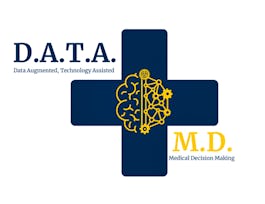This course imparts a wide range of basic knowledge and skills in the field of trauma surgical and orthopedic treatment of patients. To facilitate this, the course employs a new concept of information transfer. We follow a scientific approach and a sophisticated combination of modern teaching methods to vividly impart the taught contents. This included case-based learning, comprehensive factual knowledge, and consecutive quizzes, which help to better memorize the learned contents and later employ them in everyday situations in the field of trauma surgery.



The Basics of Trauma Surgery

Instructor: Peter Biberthaler
Sponsored by Coursera Learning Team
23,232 already enrolled
(229 reviews)
Recommended experience
What you'll learn
Trauma mechanisms and their sequelae
Fracture localization
Fracture classification
Fracture treatment according to gold standard
Details to know

Add to your LinkedIn profile
12 assignments
See how employees at top companies are mastering in-demand skills


Earn a career certificate
Add this credential to your LinkedIn profile, resume, or CV
Share it on social media and in your performance review

There are 6 modules in this course
The first part of this module is attended to familiarize the participants with the management of polytraumatized patients. They will learn about the operational procedure in a trauma room and get to know the ATLS algorithm. This standardized algorithm that is used all over the world is based on the ABCDE scheme that will be explained to you in detail. It is intended to structure complex life-threatening injuries and help you enable the survival of your patient. In the second part of this module, attendees will be introduced to the principles of fracture management. They will not only learn about bone structure and its function, but also acquire knowledge about the classification of fractures. They will get to know the three principles of conservative and operative treatment which are reduction, fixation and rehabilitation. Therefore, particular attention will be paid to the different modes of osteosynthesis. The third part of this module is the introduction to our tutorial regarding the upper extremity. In the third episode, participants will learn about clavicle fractures. First, they will be familiarized with the anatomy of the clavicle and the classification of its fractures. Subsequently, they will get to know the different injury mechanisms, the correct diagnostic investigation and figure out the right mode of therapy. Thereby, the dreaded complication of pseudarthroses will also be elaborated on. The fourth and last episode of this module is about humeral head fractures. First of all, attendees will recapitulate the most important anatomical principles. They will be acquainted with the most common classification according to Neer. The aim is to help them making therapeutical decisions which include non-operative options and operative treatment with plates or prostheses.
What's included
4 videos2 assignments
In our second module, participants will first be taught about humeral shaft fractures. Afterwards, the second part covers the field of elbow fractures. Both videos follow the same order: After learning about the basic anatomical principles, participants will be encouraged to study the epidemiology and classification of the different fractures. They will learn about the right diagnostic investigation and subsequently, they will be familiarized with the indications for different treatment options including both non-operative and surgical alternatives. In the second part of this module regarding the upper extremity, two more bone fractures will be brought closer to the participant: fractures of the distal radius, the most common fracture in human beings, as well as metacarpal fractures. Regarding fractures of the distal radius, participants will first of all repeat the basic anatomical principles. Subsequently, they will learn about the classification of those kinds of fractures, the right diagnostic investigation as well as the non-operative vs. surgical treatment options and the follow-up treatment. In terms of metacarpal fractures, participants will first of all get to know the anatomical principles, particularly the different localizations of fractures, which affect the chosen treatment and other aspects.
What's included
4 videos2 assignments
The first part of this tutorial is about two main pathologies of the hand in traumatology. In the first video, participants will learn about the anatomical principles of the scaphoid bone as well as the epidemiology of its fractures. Subsequently, they will be familiarized with its classification and the particular treatment. The second episode covers ruptures of the extensor tendon in the hand. Just like in the other modules of the Basics of Trauma Surgery, this course starts with an anatomic introduction to the localization, followed by epidemiologic explanations of the state-of-the-art treatment of injuries to this region. In the second part of this module, participants will primarily study fractures of the thoracic and lumbar spine followed by cervical spine injuries. They should envision the anatomy of the spine and the epidemiology as well as the most common injury mechanisms of related fractures. Participants should attach great importance to the clinical-neurological examination. They will be familiarized with both the vertebra model according to Denis and the classification according to Magerl for fractures of the thoracic and lumbar spine as well as a classification for injuries of the upper cervical spine. Different treatment options are presented, e.g. by ventral or dorsal stabilization. The fourth and last video of this module is about pelvic injuries. After explaining the basic anatomical principles and the danger of hemorrhage, participants will be familiarized with the epidemiology and classification of pelvic ring fractures. Furthermore, different treatment options will be highlighted.
What's included
4 videos2 assignments
In this module, participants will learn about fractures of the femur. The first video is about fractures of the proximal femur that can be subdivided into fractures of the head and neck as well as pertrochanteric and subtrochanteric fractures. Especially the blood supply of the proximal femur is a crucial concern in fractures. Different treatment objectives and options are therefore highlighted. The second video continues with fractures of the femoral shaft. Participants will learn about the basic anatomical principles and their consequences for fractures of this area. After getting to know the epidemiology of femoral shaft fractures and their underlying accident mechanism, different options for operative treatment are presented. In the second part of the module, participants will learn about two more main traumatological pathologies of the lower extremity. The third video is about fractures of the ankle joint. After getting to know the basic anatomy and the trauma mechanism, participants should internalize the classification, which is important for the further procedure. In addition, the clinical and radiological examination will be highlighted.
What's included
3 videos2 assignments
The first part of this module is about tibial head fractures. Analogous to the preceding modules, the anatomical basics are covered first. Furthermore, there is an introduction to the classifications of this type of fracture. The participants will subsequently learn about the correct diagnostic examination as well as the different treatment options, conservative and surgical measures as well as adequate follow-up schemes. Afterwards, the module treats two further very common entities in traumatology: traumatic brain injury (TBI) and cut wounds and their treatment by means of adequate wound suture. Just like in the other modules, we first focus on the introduction of the anatomy of the skull and afterwards, accident mechanisms of this body region are shown. Subsequently, details on the particular risks associated to head injuries are provided and how these dangerous consequences of an accident can be treated correctly. In the last part of the module, we finally cover cut injuries and their treatment by means of wound suture. Like before, we first introduce possible injury mechanisms, followed by the state-of-the-art treatment of these injuries.
What's included
3 videos2 assignments
In this final module of our course, we initially address two further common everyday injury mechanisms: bite wounds, which can for example be caused by animal bites and which are often underestimated. This is particularly dangerous, as they can be associated with serious infections. First, we focus on the incidence of these injuries and subsequently on the correct treatment by means of wound suture and antibiotics. The second video of the module covers burn injuries, which are injuries that can also occur unexpectedly every day, for example as a result of mishaps in the kitchen. Initially, we outline the basics of burn injuries, followed by a detailed description of wound management of this particular traumatic entity. In the final teaching unit of the Basics of Trauma Surgery of TUM, we detail on a dangerous injury pattern: penetrating injuries to the thorax. Just like in the preceding modules, this unit starts with an epidemiologic classification and the basics of these often life-endangering injuries. The course eventually closes with a detailed explanation of the necessary imaging and correct therapeutic options, which are indispensable to ensure survival and satisfactory recovery of the affected patients.
What's included
3 videos2 assignments
Instructor

Offered by
Why people choose Coursera for their career




Learner reviews
229 reviews
- 5 stars
69.86%
- 4 stars
20.08%
- 3 stars
5.24%
- 2 stars
2.18%
- 1 star
2.62%
Showing 3 of 229
Reviewed on Jul 31, 2020
Excellent for learning new basic things, very interesting. Despite its in german subtitles are very usefull and also the ppts.
Reviewed on Apr 30, 2022
Tons of information. English subtitles sometimes don't synchronize with spoken German. But, a useful course that is very well produced.
Reviewed on Jun 24, 2020
Great course. I am an Orthopaedic Surgery resident and I have found this course very useful. Highly recommended.
Recommended if you're interested in Health

Rice University

University of Florida

University of Michigan

Yale University

Open new doors with Coursera Plus
Unlimited access to 10,000+ world-class courses, hands-on projects, and job-ready certificate programs - all included in your subscription
Advance your career with an online degree
Earn a degree from world-class universities - 100% online
Join over 3,400 global companies that choose Coursera for Business
Upskill your employees to excel in the digital economy


